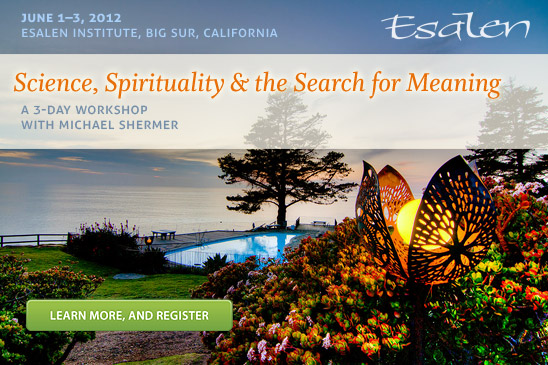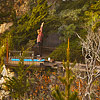In this week’s eSkeptic:
A 3-Day Workshop with Michael Shermer
presented by the Esalen Institute, Big Sur, CA
June 1–3, 2012
JOIN MICHAEL SHERMER for a 3-day workshop in one of the most beautiful locations on the planet: the Esalen Institute in Big Sur, California, situated on “120 acres of fertile land carved out between mountain and ocean” (located right on Pacific Coast Highway overlooking the crashing waves of the Pacific Ocean below).
Between workshops, there is plenty to do at Esalen. Experience magnificent hiking in the local mountains, or join Michael Shermer for a wonderful cycling trip up and down the coast. Visit the Arts Center, stroll through the beautiful farm and gardens or get your feet wet at the easily accessible beach. Tempt your taste buds with delicious, healthy food, and pamper yourself with a relaxing massage (which, according to Michael, is the best he’s ever had)! Join in the post-workshop discussion and a soak in the waters of the centuries-old natural hot spring that gushes out of the cliffside at 119 degrees (80 gallons/minute) and flows into a hot tub perched 50 feet above the Pacific Ocean!
“Esalen is one of the finest resort spas I’ve ever seen—well worth experiencing even if there was no workshop at all! This is a weekend adventure you won’t want to miss!”
Experience Esalen (click an image to enlarge it)
Click any photo to enlarge. Then, click the left or right side of the enlarged photo to view other photos. All photos copyright © 2012 Esalen Institute, used with permission.
Workshop Schedule
Each of the five 2-hour sessions will consist of a 90-minute lecture followed by 30 minutes of Q&A and audience discussion. Please note that there is plenty of “down time” between sessions for additional discussions over meals (and hot tubs)!
- FRIDAY, JUNE 1, 8:30 PM –10:30 PM
- The Believing Brain: From Ghosts and Gods to Politics and Conspiracies—How We Construct Beliefs and Reinforce Them as Truths
- SATURDAY, JUNE 2, 9:30 AM–1:00 PM
- Why Darwin Matters: Science and Religion in Evolution; Why People Believe in God
- LATER ON SATURDAY, JUNE 2, 7:15 PM–10:15 PM
- The Science of Good and Evil: Why People Cheat, Gossip, Care, share, and Follow the Golden Rule
- SUNDAY, JUNE 3, 9:30 AM –11:30 AM
- The Moral Arc of Science: How Science and Reason Have Bent the Arc of the Moral Universe Toward Truth, Justice, Freedom & Prosperity
Esalen Meals and Times
The food at the Esalen Institute is magnificent and healthy. And it’s very social seating so we can all hang out together during meals as well as the workshop discussions.
BREAKFAST: 8:30 am – 9:45 am
LUNCH: 12:30 pm – 1:45 pm (SUNDAY BRUNCH 12:15 pm – 1:30 pm)
DINNER: 6:00 pm – 7:30 pm
Weekend Fees (including workshop)
The price for the weekend depends on the room selection: a Standard room is $730; a Premium room is $1210. Price includes all meals. Esalen requests a $150 deposit to reserve your place. Balance of payment is due five days before the workshop begins. Reservations must be made through the Esalen Institute, not through the Skeptics Society or Michael Shermer. At these prices (including the workshop) your weekend will probably cost less than the resorts and spas at expensive hotels up and down the coast.
This is not a Skeptics Society event. The Skeptics Society is not sponsoring this event, nor do we profit from it.
Contact
programs@esalen.org (programs)
info@esalen.org (general mailbox)
About Michael Shermer

DR. MICHAEL SHERMER is the Founding Publisher of Skeptic magazine and editor of Skeptic.com, a monthly columnist for Scientific American, and an Adjunct Professor at Claremont Graduate University. Dr. Shermer’s latest book is The Believing Brain: From Ghosts and Gods to Politics and Conspiracies—How We Construct Beliefs and Reinforce Then as Truths. Dr. Shermer’s previous book is The Mind of the Market, on evolutionary economics, and prior to that he released Why Darwin Matters. He is the author of The Science of Good and Evil and of Why People Believe Weird Things. Dr. Shermer received his B.A. in psychology from Pepperdine University, M.A. in experimental psychology from California State University, Fullerton, and his Ph.D. in the history of science from Claremont Graduate University (1991). He was a college professor for 20 years, and since his creation of Skeptic magazine he has appeared on such shows as The Colbert Report, 20/20, Dateline, Charlie Rose, Oprah, Leeza, Unsolved Mysteries, and Larry King Live. He has also done interviews in countless documentaries aired on PBS, A&E, Discovery, The History Channel, The Science Channel, and The Learning Channel. Check out Michael Shermer’s page at Shop Skeptic.
About this week’s eSkeptic
In this week’s eSkeptic, Tina Dupuy examines the history of straw men inherent in anti-abortion and other vilification campaigns. Dupuy is an award-winning writer, investigative journalist, and managing editor of Crooks and Liars. Tina appears frequently on MSNBC, Current TV, RT and BBC and all over the radio frequencies via KCRW’s To The Point, The Stephanie Miller Show, The Block Radio and The Leslie Marshall Show. She writes for Los Angeles Times, The Atlantic, Fast Company, Alternet, LA Weekly and Newsday among many others. Her weekly op-ed column is nationally syndicated through Cagle Cartoons.

Fetus Food
Another Urban Legend Busted
by Tina Dupuy
Freshman Oklahoma state senator Ralph Shortey recently introduced a bill that would ban “the sale or manufacture of food or products which contain aborted human fetuses.” After a collective brow-raise over such a bizarre proposal, Shortey told the Los Angeles Times he got the idea “while doing some research on the Internet.”
So is there an issue with aborted fetuses ending up as foodstuffs? No. And there never has been.
Shortey’s bill is a wild overstatement of the latest front in the anti-abortion fight, one being prosecuted on an obscure Oklahoma anti-abortion website that has been trying to organizing a campaign to boycott PepsiCo because of a research contract it has with a company called Senomyx for beverage sweetener research that the anti-abortion activist charge involves using the HEK-293 cell line in laboratory tests. HEK-293 is a cell line developed in Holland in the early 1970s through the fusion of a kidney cell from an aborted fetus and a virus that immortalized the cells, or allowed them to keep replicating in a laboratory. “Senomyx does not provide ingredients to PepsiCo, nor do they manufacture PepsiCo products. Our work with Senomyx is focused on beverage sweetener research to help us reduce sugar in future global products,” according to Pepsi.
But solving a problem is not the real goal of proposing a ban.
Shortey’s bill sits squarely in a tradition of vilification that’s existed longer than English, mass media, or even Christianity. It’s the timeless Blood Libel: the blood drinking straw man who’s been given different titles over the millennia. Not only do abortionists kill babies, the bill implies, they want us all to commit the most culturally repulsive of all offenses—cannibalism.
The first recorded Blood Libel is from 31 AD. It’s told by two Jewish historians, who lived in the first century in then-Roman Alexandria, Egypt: Philo, in his account of Flaccus the Lieutenant-Governor of Egypt; and Flavius Josephus, in his work, “Against Apion.”
Here’s what these sources tell us: Apion was a skilled hyperbolist and Lieutenant-Governor Flaccus was a desperate politician who tried to avert Caligula’s wrath.
Around 30 AD, Apion, a Graeco-Egyptian grammarian and writer, had spent a great deal of time spreading nasty snipes about the Jewish citizens of Alexandria. His motives for this pastime have been lost to history, but Apion claimed Jews worshiped weird gods and refused to have images of the emperor in their temples. Oh, and to make this all worse, he whispered to many a curious audience that the Jews had been led out of Egypt because they were lepers.
Apion created a narrative. He wrote that it was a part of Jewish law to kidnap a Greek once a year and fatten him up and taste his entrails. Jews were cannibals
Lieutenant-Governor Flaccus used the suspicions about the Jews as a wedge to curry favor with the new emperor. Since the Jews of Alexandria were against Caligula, Flaccus appointed himself as the guy to remedy the problem.
Thousands of Alexandrian Jews—men, women and children—were tortured and killed as a direct result of Apion’s defamations, a pioneering set of slanders that have proved to have real staying power.
Propaganda depends on things sounding vaguely familiar, lending a veneer of credibility to false claims. This is also why repetition is a popular tactic to sway public opinion—the creation of familiarity, which is then mistaken for truth. The Jews are not the only group to have suffered from slander campaigns; they also have been waged against alleged witches, gypsies and many other outsiders, often with equally dire consequences.
In the 19th century, Catholics were a popular target of sharp and false tongues in the U.S. The most widely read book of that century here was Uncle Tom’s Cabin. Also widely read was a memoir by a woman calling herself Maria Monk titled, Awful Disclosures of Maria Monk: or, The Hidden Secrets of a Nun’s Life in a Convent Exposed, published in 1836. The book claimed to be the first-hand account of a former nun in a Quebec convent, and to provide an insider’s view of Catholics. One of her claims was that there were libraries packed full of books and not one bible. Another allegation: Not only were the priests having sex with the nuns, the unsuspecting narrator had stumbled upon a room where the convent kept baby corpses. Yes, the Catholics, who already ceremonially drink the blood of their Savior, also were killers of babies. Piles of them. Because that way the illegitimate but baptized infants would ascend to heaven more rapidly—without any further sinning.
The book was a sensation—perhaps the most widely read book in America before Uncle Tom’s Cabin was published, according to Richard J. Hofstadter’s seminal 1964 essay, “The Paranoid Style in American Politics.” And its tale was, of course, false. Even basic facts about the convent where “Monk” claimed to live were not true. The book was totally debunked—but not before it had burrowed into the popular imagination. Most of the century’s immigrants, the 19th century underclass, were from Catholic countries, and any justification for scorning them was welcomed. The Nativist movement and the Know-Nothings thrived on anti-Catholic sentiment. And remember, the Klu Klux Klan was not just terrorizing black people in the south—they were also terrorizing Catholics.
An example closer to our own time was the Satanic Panic of the 1980s. That decade saw widespread allegations of very specific type of Satanic cult conspiracy which, in retrospect, had all the elements of a classic Blood Libel. On a 1988 ABC special, the channel’s then-resident schlock hawk, Geraldo Rivera, did his utmost to enlighten the general public about something evangelicals had held true for years. “Estimates are that there are over one million Satanists in this country,” Rivera declared in prime time. “The majority of them are linked in a highly organized, very secretive network. From small towns to large cities, they have attracted police and FBI attention to their Satanic ritual child abuse, child pornography and grisly Satanic murders. The odds are that this is happening in your town!”
The Satanic Panic was a whiplash from the cultural revolution of the 1970s, a cultural spasm that oddly united therapists and evangelicals. The Christian community had some self-proclaimed former Satanic Priests in their ranks dishing about all the children’s blood they used to drink and the therapists had some new and “innovative” (read: questionable) ways to “recover memories” of being the victims of the Satanic conspiracy. Both schools took over a decade or two to completely discredit.
A 1989 study by the Committee for the Scientific Examination of Religion published in the book Satanism in America: How the Devil Got Much More than his Due by Shawn Carlson, Gerald LaRue and others reported there were 33 organizations and 90 individuals who were actively promoting the Satanism scare. This was a conspiracy all right—just not the one depicted on talk shows with depressed-looking teenagers. Nevertheless, these Satan experts were not only on news programs and at conventions—they were teaching law enforcement seminars on how to spot and investigate Satanic crimes.
The Satanic Panic was barely mentioned in the recent release of the West Memphis Three, the three now thirty-somethings who have spent nearly 20 years in prison for little more than wearing black clothes in a small southern town in 1993. Three 8-year-old boys were murdered in May of that year. And because Jessie Misskelley, 17, Jason Baldwin, 16, and Damien Echols, 18, fit the profile of what was thought at the time to be a Satanist (as in someone who killed children for sport and listened to heavy metal), they were railroaded, found guilty and sentenced to life. Echols was sentenced to death. It took two decades and dozens of celebrities to get them out of jail. Blood libels are far reaching.
The point of rehearsing these historical episodes is this: When a junior senator from the same state that banned Sharia Law proposes to ban feeding Oklahomans aborted baby fetuses, it’s not just some wacky guy in a square state being eccentric.
There is a long and storied global history of demonizing groups of people with whom you disagree by tarring them with the charge of cannibalism—tapping into one of humanity’s deepest and most firmly held taboos. The consequences of such charges have often been deadly. Abortion service providers are already routinely harassed, threatened, shot at and even bombed. Casting them now as handmaidens to cannibalism is just the next extreme step in turning the decades-long effort to make them into pariahs.
Skeptical perspectives on urban legends & critical thinking…
-
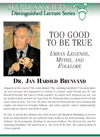 Urban Legends
Urban Legends
by Dr. Jan Harold Brunvand
-
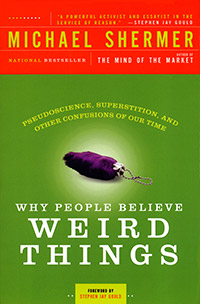 Why People Believe Weird Things: Pseudoscience, Superstition, and Other Confusions of Our Time
Why People Believe Weird Things: Pseudoscience, Superstition, and Other Confusions of Our Time
by Michael Shermer
-
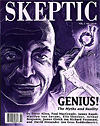 Genius: Myth and Reality
Genius: Myth and Reality
Skeptic magazine volume 2, number 1
-
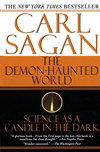 The Demon-Haunted World:
The Demon-Haunted World:
Science as a Candle in the Dark
by Carl Sagan


